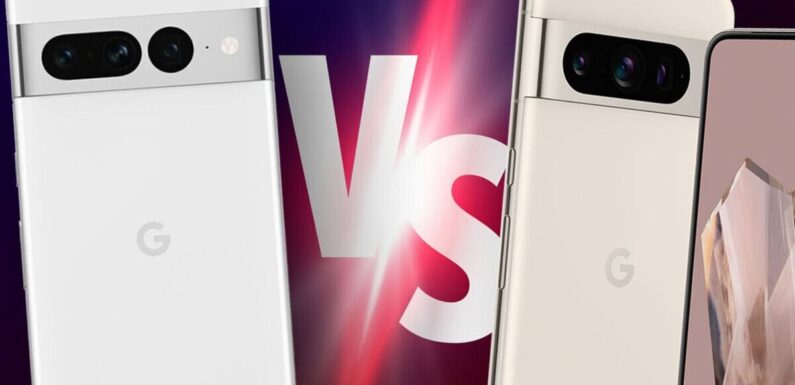
JUMP TO…
Google has just announced the Pixel 8 Pro, it’s biggest and best smartphone to date, with a brighter, flatter screen, smarter cameras, and new colour options. Launched alongside a smaller Pixel 8 phone and updated Pixel Watch 2 smartwatch, Google is hoping the Pixel 8 Pro will prove the shot in the arm the company needs to boost its Android phone sales and take some market share from Samsung.
Though the Pixel 8 Pro is new, it’s not a total overhaul of the Pixel 7 Pro, a phone we reviewed and loved in 2022. It had great design, top tier cameras, and slick Android software.
Here, we compare the Pixel 8 Pro to the Pixel 7 Pro to see if it’s worth upgrading if you have the older phone, find out if the new one is worth the extra money, and all the differences between the two handsets.
So, what are the main differences between the Google Pixel 8 Pro and Google Pixel 7 Pro?
Design
- Metal frames
- Glass front and back
- Different colour options
The Pixel 8 Pro looks quite similar to the 7 Pro, but there are some design differences. The new Pro comes in Obsidian (black), Porcelain (beige), and Bay (blue), compared to the 7 Pro’s Obsidian (black), Snow (white), and Hazel (grey/green).
On the back you get three cameras on each device, though on the 8 Pro they’re all within one black rounded shape whereas on the 7 Pro two of them are in a smaller oval with a third lens in a circular cut out on its own.
Both phones have a single circular front facing camera cut out at the top of their displays, USB-C charging ports on the bottom, and a volume rocker and power button on the right edge – and a Google ‘G’ logo slap bang in the middle on the back of each device.
The Pixel 8 Pro tips the scales at 213g, practically the same as the 121g Pixel 7 Pro. They’re both large phones thanks to their massive displays: the Pixel 8 Pro measures 162.6 x 76.5 x 8.8mm while the Pixel 7 Pro is 162.9 x 76.6 x 8.9mm – basically identical.
Be one of the first to get your hands on the all-new Pixel 8 Pro, and Google will bundle in its brand-new Pixel Watch 2 smartwatch (worth £349) for free. Both devices will ship on release date on October 12, 2023
Screen
- Flat screen on 8 Pro
- Curved screen on 7 Pro
- Both 6.7 inch and 120Hz
Both the Pixel 8 Pro and Pixel 7 Pro have large 6.7 inch displays, but the former’s is flat and the latter’s is curved at the edges, one of the main differences between the two phones.
The 7 Pro’s display is pin-sharp and has an ever so slightly different 19.5:9 aspect ratio compared to the 8 Pro’s 20:9 display. Both screens have smooth 120Hz refresh rates so apps and text scroll very fluidly, but the Pixel 8 Pro’s tech can scale all the way down to 1Hz when there’s not much happening on the screen, which is great for battery life and efficiency.
Both phones have always-on displays so you can glance at key information such as time, notifications, and weather even when the screen is otherwise off – and when they’re on, the 8 Pro can boost to a maximum brightness of 2,400 nits compared to the 7 Pro’s not-quite-as-bright 1,500 nits.
If you’re worried about scratches and cracks in your screen, the Pixel 8 Pro goes one better with Gorilla Glass Victus 2 for its screen rather than the older Gorilla Glass Victus on the 7 Pro.
Cameras
- Main, telephoto, and ultrawide on both
- 50Mp main camera on both
- Smarter camera software on 8 Pro
Google Pixel phones are renowned for their excellent camera quality, and the Pixel 7 Pro is one of the very best thanks to its 50Mp main sensor. Google’s secret sauce is in its computational photo processing, where software magic tubes up your photos to their best possible quality after you’ve tapped the shutter button.
Photos are excellent, among the best we’ve ever seen on a smartphone. Alongside that main lens is a 12Mp ultrawide camera and a great 48Mp 5x optical telephoto lens – plus Google’s clever software called Super Res Zoom that can take very good 10x zoom shots, and slightly less good ones at 30x, using digital zoom and AI to correct blur and pixelation.
In comparison, Google describes the Pixel 8 Pro’s cameras as “fully upgraded”, and promises better low-light photos, sharper selfies, and better zoom quality compared to older Pixels like the 7 Pro. It has a 50Mp main sensor that is identical on paper to last generation, and a 48Mp telephoto camera with similar 5x optical zoom. The upgrade is in the wide-angle camera which is a 48Mp sensor too and will hopefully bring better quality and detail to shots.
At launch, some of the upgrades to the Pixel 8 Pro’s camera aren’t actually available yet, such as Night Sight for video – a night mode for video that brightens results to be more visible – and Magic Editor, that lets you move subjects around in photos and change other things thanks to onboard AI power. That said, some of these features could come to the 7 Pro too in a software update, we just don’t know yet.
One of these currently Pixel 8 exclusive features is Magic Audio Eraser, which can remove unwanted audio from videos. Both phones get a Pro mode in the camera app though, for advanced controls when taking snaps.
Performance and specs
- Better chipset on 8 Pro
- 12GB RAM on both
- 1TB option for 8 Pro
The Pixel 8 Pro has Google’s newer Tensor G3 chipset rather than the 7 Pro’s G2, but both phones have a generous 12GB RAM. The 8 Pro is the first Pixel to get a 1TB storage option as well as the 128GB, 256GB, and 512GB options you can also get the 7 Pro in.
Google says the 8 Pro’s T3 chip powers the AI features in the phone’s camera and other apps to run even better than before, so you can hopefully make big edits to photos and videos on the phone without it grinding to a halt. It touts its Call Screen feature as a big reason to buy it, but it’s only widely available in the US – it screens spam calls so you don’t have to deal with them.
There’s also improved Clear Calling on the Pixel 8 Pro for even better voice call quality, though we found the 7 Pro pretty great for calls already. Above all, we hope the Tensor G3 is powerful enough to last over a longer period of time – the earlier versions of the chipset in the Pixel 6 Pro and 7 Pro have not been received as well as rival chipsets from Samsung and Apple in phones such as the Galaxy S23 Ultra and iPhone 15 Pro.
Battery and charging
- Both 30W maximum wired charging speed
- Both have wireless charging
- Neither have charger in box
We found the Pixel 7 Pro had decent, all-day battery life thanks to its large 5,000mAh capacity. Google promises ‘beyond’ 24 hours of battery or 72 hours on its Extreme Battery Saver mode (that no one will use because it kneecaps most of the phone’s features, but is good for emergencies). The company estimates the Pixel 8 Pro’s battery life as exactly the same, despite a small size bump to 5,050mAh.
It’s a shame that Google hasn’t upgraded the Pixel 8 Pro’s charging speeds – both it and the 7 Pro charge up to 50% in 30 minutes, but there’s no charger in either box, only a USB-C cable. You can charge both wirelessly if you have a wireless charging pad, and both have reverse wireless charging to top up other phones or accessories like earbuds.
While it’s no longer the latest Pro-level Pixel handset from Google, there’s still a lot to love about this brilliant phone. With its trademark Magic Eraser feature, you can remove unwanted people from the background of your shots, and AI can screen your calls – ditching spam callers before your phone starts ringing!
Software
- Both run Android
- Pixel 7 Pro supported until 2027
- Pixel 8 Pro supported until 2030
One of the best upgrades for the Pixel 8 Pro is its promised software support. For the first time, Google is offering seven years of Android OS updates and seven years of security updates too.
Whether or not this means the Pixel 8 Pro will launch on Android 14 and end support in 2030 with a full version of Android 21 remains to be seen, but it’s a big step up from the three years of Android updates and five years of security updates the Pixel 7 Pro is due for.
The Pixel 7 Pro launched on Android 13 but will get updated to Android 16 over the coming years. It should get Android 14 some time in late 2023, as the Pixel 8 Pro is one of the first phones to launch with that version.
Price
- 7 Pro starts at £849
- 8 Pro £150 more at £999
The Pixel 8 Pro costs from £999 for the model with 128GB storage, putting it at the same price as Apple’s iPhone 15 Pro.
You can buy the Pixel 8 Pro direct from Google in the UK.
This is a price rise over the Pixel 7 Pro, which costs £849 for the 128GB version. You can still buy it from Google, though it’s likely to have limited stock left. It’s also for sale at Amazon, Argos, Currys, and John Lewis.
Verdict
The Pixel 8 Pro should be a superb phone – probably the best Google has ever made. Its cameras have the best specs yet, the design is refined to a T, and with seven years of software support it’s a phone that’s going to last you.
If you can’t stomach the £999 price tag, the Pixel 7 Pro is still a solid buy. It has many of the same features, and it’ll get software updates till 2027, but its hardware will show its age sooner than the 8 Pro. The Pixel 8 Pro is the better of the two phones.
Source: Read Full Article


